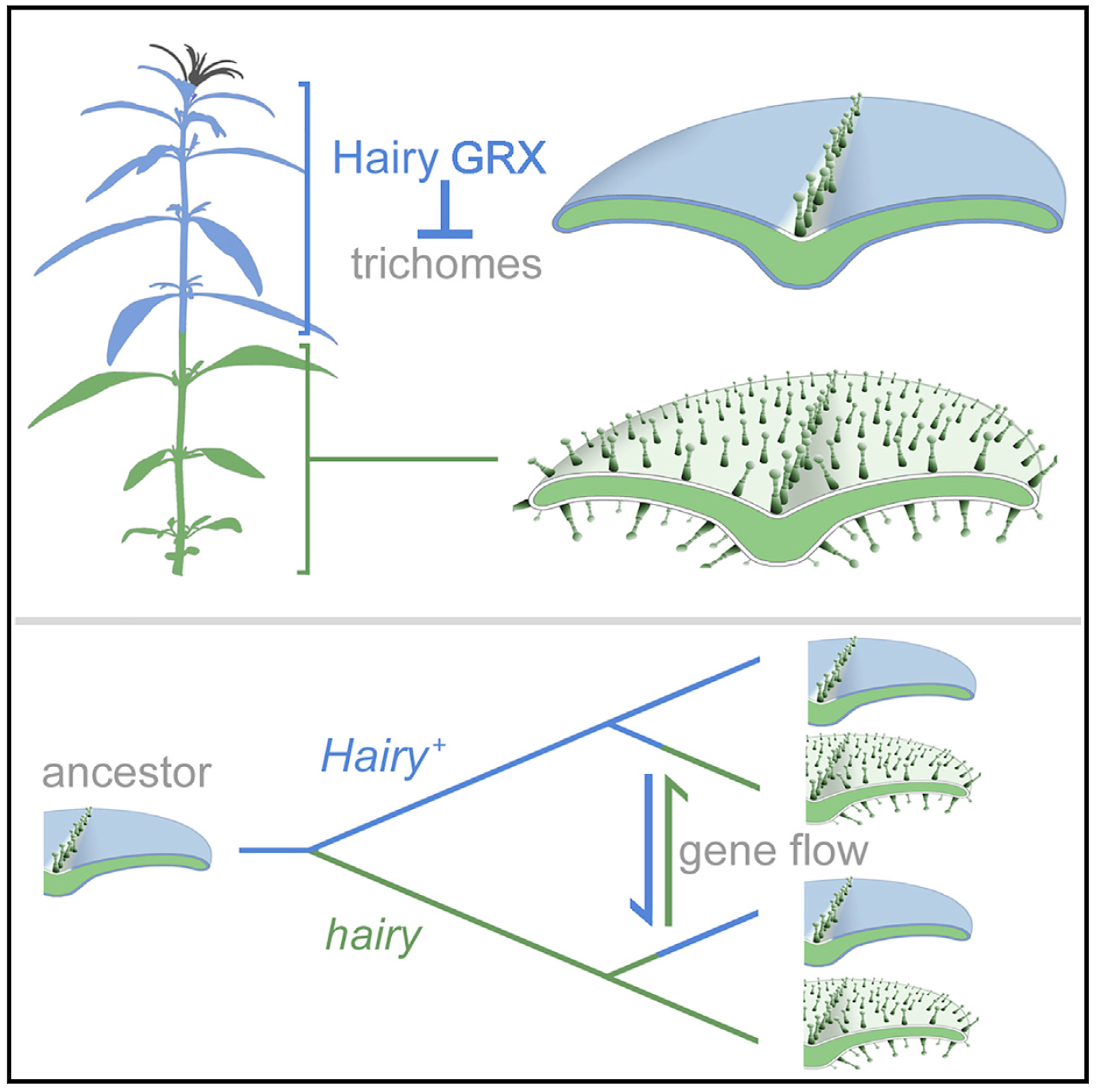博文
Current Biology:金鱼草多细胞毛状体模式演化的遗传基础
||
Shared Mutations in a Novel Glutaredoxin Repressor of Multicellular Trichome Fate Underlie Parallel Evolution of Antirrhinum Species
First author: Ying Tan; Affiliations: University of Edinburgh (爱丁堡大学): Edinburgh, UK
Corresponding author: Andrew Hudson
Most angiosperms produce trichomes—epidermal hairs that have protective or more specialized roles. Trichomes are multicellular in almost all species and, in the majority, secretory. Despite the importance of multicellular trichomes for plant protection and as a source of high-value products, the mechanisms that control their development are only poorly understood. Here, we investigate the control of multicellular trichome patterns using natural variation within the genus Antirrhinum (snapdragons), which has evolved hairy alpine-adapted species or lowland species with a restricted trichome pattern multiple times in parallel. We find that a single gene, Hairy (H), which is needed to repress trichome fate, underlies variation in trichome patterns between all Antirrhinum species except one. We show that H encodes a novel epidermis-specific glutaredoxin and that the pattern of trichome distribution within individuals reflects the location of H expression. Phylogenetic and functional tests suggest that H gained its trichome-repressing role late in the history of eudicots and that the ancestral Antirrhinum had an active H gene and restricted trichome distribution. Loss of H function was involved in an early divergence of alpine and lowland Antirrhinum lineages, and the alleles underlying this split were later reused in parallel evolution of alpines from lowland ancestors, and vice versa. We also find evidence for an evolutionary reversal from a widespread to restricted trichome distribution involving a suppressor mutation and for a pleiotropic effect of H on plant growth that might constrain the evolution of trichome pattern.

大多数的被子植物会产生毛状体,一种表皮的毛细胞,具有保护或者更加特化的功能。毛状体几乎在所有物种中均是多细胞,并且大多数情况下属于分泌型。多细胞毛状体对于植物具有重要的保护作用,并且是植物高价值产物的来源之一,但我们对于控制毛状体发育的分子机制至今还不甚了解。本文中,作者利用金鱼草属中出现的自然变异研究了控制多细胞毛状体模式建成的分子机制,金鱼草属不同物种演化出了高山适应性的多毛物种以及低地适应的毛状体发育受限物种(多次平行演化)。作者发现了一个单基因Hairy是毛状体命运的抑制因此,该基因作用于几乎所有金鱼草属物种的毛状体发育模式自然变异。作者的研究显示Hairy基因编码一个新的表皮特异性谷氧还蛋白(glutaredoxin),并且不同金鱼草个体上毛状体分布模式与Hairy基因的表达模式相一致。系统发育分析以及功能试验显示Hairy基因在双子叶植物演化历史的后期获得了其抑制毛状体发育的功能,而金鱼草属的祖先具有一个活性的Hairy基因,并且在后期从低地向高低的平行演化中被多次利用来控制毛状体的发育,反之亦然。作者还发现从毛状体广泛分布到局限分布的祖征重现涉及到了一个抑制子突变,并且Hairy基因对于植物生长的多效性作用可能限制了毛状体模式的演化。
Highlights
Hairy encodes a trichome-repressing glutaredoxin
Hairy基因编码一个抑制毛状体的谷氧还蛋白
Phased Hairy expression determines which tissues are bald
Hairy基因的定相表达决定了哪些组织表面“光秃”
Hairy alpine Antirrhinum species lack Hairy function
多毛高山金鱼草物种缺少Hairy蛋白功能
Old hairy mutations were used in evolution of new alpine species
新的高山金鱼草物种演化利用了相同的hairy突变
通讯:Andrew Hudson (http://hudson.bio.ed.ac.uk/content/research)
研究方向:利用金鱼草和拟南芥研究植物多态性和适应性的遗传基础。
doi: https://doi.org/10.1016/j.cub.2020.01.060
Journal: Current Biology
Published date: February 27, 2020

https://blog.sciencenet.cn/blog-3158122-1221772.html
上一篇:Nature Communications:植物表皮通过phyB-PIF4-生长素模块调控热形态发生
下一篇:Current Biology:植物整合环境信号与BR信号根据实际环境条件塑造植株的生长
全部作者的其他最新博文
- • Plant Physiology:CsMADS3促进柑果中的叶绿素降解和类胡萝卜素合成(华中农业大学)
- • Molecular Plant:LBD11-ROS反馈调节作用于拟南芥的维管形成层增殖和次生生长(浦项科技大学)
- • Science Advances:根结线虫通过调控植物的CLE3-CLV1模块,促进侵染进程(日本熊本大学)
- • Nature Communications:油菜素内酯参与植物营养生长期转变的分子机制解析(浙江农林大学)
- • Current Biology:光合作用产生的蔗糖驱动侧根“生物钟”(德国弗莱堡大学)
- • PNAS:花同源异型基因在叶中被抑制、花中被激活的分子机制(南卡罗来纳大学)